We have a strict honesty policy, but please note that when you buy through our links, we may earn a commission. Learn more.
Written by Chris Singleton | Researched and reviewed by Matt Walsh

In this GrowthBar review, I take an in-depth look at a low-cost tool that aims to combine AI copywriting tools with traditional SEO features.
The quick verdict
GrowthBar’s main selling point is that it combines useful AI copywriting features with basic SEO tools at a low price point. So long as you are prepared to spend time factchecking and editing the content produced by its AI features, GrowthBar can be a very useful tool for content creation.
The SEO tools provided are fairly feature light however — for serious keyword research and backlink analysis, I’d look in the direction of alternative SEO tools.
Keyword research and backlink building are absolutely vital aspects of search engine optimization — but they can be very expensive activities.
Many of the leading SEO tools cost a minimum of $99 per month; and hiring an agency to work on an SEO campaign can involve a much larger investment than that.
Spotting a desire amongst startups and businesses on a budget to avoid these sorts of costs, growth marketers Hailey Friedman and Mark Spera came up with a new product, ‘GrowthBar,’ that aims to provide not just traditional SEO tools but AI features too, and at a much lower price point — from as low as $20.30 per month depending on available discounts.
But is it any good?
Let’s find out…
What is GrowthBar?
GrowthBar is an SEO tool that can be used in two ways.
First, it can be used as a standalone web app — where you log in, enter keywords, access stats and so on.
Alternatively, it can be used as a Chrome extension, which differentiates it from most of the well-known SEO tools out there — Moz, Semrush, Ahrefs etc. These tend to work exclusively as standalone web applications, rather than plugins or extensions.

If you’d like to use the GrowthBar Chrome extension, you’ll obviously need to ensure that you have the Chrome browser installed on your computer; you’ll also need a Google account.
The ‘standalone’ version of Growthbar
The philosophy behind GrowthBar is to strip out the more advanced SEO features that are typically provided by the established SEO tools, so that users can focus on the absolutely vital metrics.
Accordingly, when you log into the ‘standalone’ version of GrowthBar, you encounter just a few SEO features.
There are two main SEO feature sections to consider: ‘AI Tools’ and ‘SEO Tools’.

In the AI tools section, you’ll find:
- a blogpost generator — based on a phrase you give it, this ‘AI’ feature generates content outlines for your blog posts or site pages, along with suggestions regarding the best titles, introductions, keywords, word counts, headers and images to use in it.
- a chat tool —this lets you chat with Growthbar’s integrated version of ChatGPT to gather data and perform research.
- a paragraph generator – this provides you with paragraph copy based on a topic you enter.
- a paragraph rewriter — this lets you enter a paragraph and have Growthbar come up with an alternative one for you.
- a meta description generator — this gives you suggestions for meta descriptions based on phrases you enter.
- blog ideas – this outputs a list of blog post titles based on a keyword you supply.
- an email newsletter creator — this creates email content for your brand newsletters based on your prompts.
- a press release generator — this lets you enter your announcement and have Growthbar come up with a full press release text for you.
- a product description writer — this automatically produces product descriptions for you based on your inputs.
- a sales email generator — this lets you describe the goal / scenario of your sales email and creates a full draft of an email for you.
- a ‘Blog Post To LinkedIn‘ tool — this lets you enter the URL of your blog post and generates an announcement text for you to post on LinkedIn to make an announcement to your connections.
- a ‘Blog Post To Twitter/X‘ tool — similar to the LinkedIn tool above, this tool lets you enter a URL and then generates text for you to use in a Tweet about your blog post.
In the Research tools section, you’ll find:
- A keyword research tool — this allows you to find out how many searches there are for a given keyword.
- A ‘Keyword roadmap‘ tool — this analyses your (and your competitor’s) keywords to help you optimize existing content and create new content based on an ‘opportunity score’ rating.
- A site inspector — this gives you basic information on a website (authority, estimated traffic per month, backlinks and Google CPC data)
- A rank tracker — this lets you enter a domain along with a list of keywords and check / track how it ranks for them.
Let’s look at each of some of the key ones in turn.
Content tools in GrowthBar
The blogpost generator
GrowthBar’s ‘blogpost generator’ tool uses AI (artificial intelligence) to help you create new blog posts and web pages, and is positioned as its star feature.
There are a few different ways to use it, but it all starts with you entering a keyword phrase and article title that you’d like ideas for into the content generator.
(For my test, I decided to use it to create some content about my home city, Dublin.)
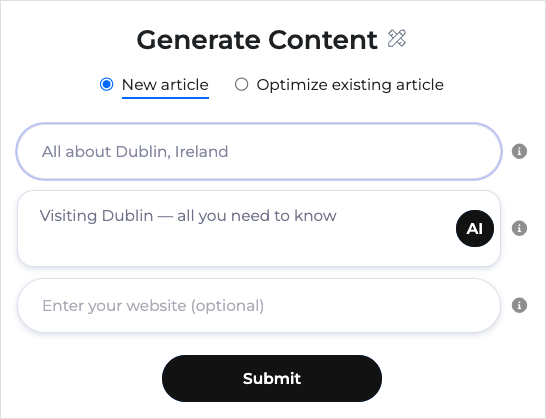
Once you’ve done that, you’ll see Growthbar’s ‘2-minute first draft builder’.
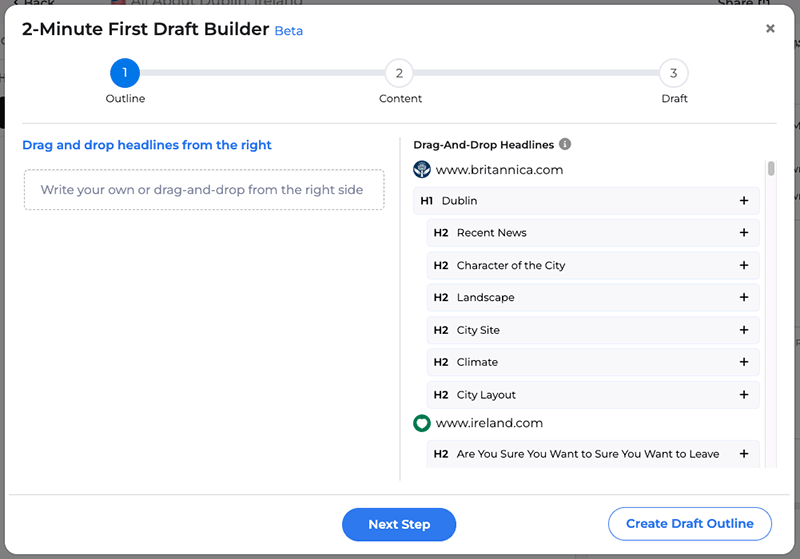
This shows you a list of headlines found on sites that already rank highly for the topic — you can drag and drop these into your article and ask GrowthBar to create content for them.

The blogpost generator then generates a set of content bullet pints under each of your chosen headings. You can click into these to edit them or delete any that you don’t want to use in your article.
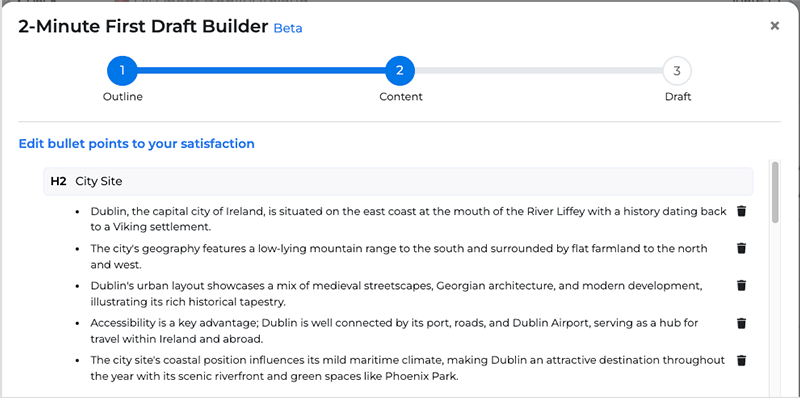
You’re next taken to a screen where Growthbar generates a complete draft of your article.
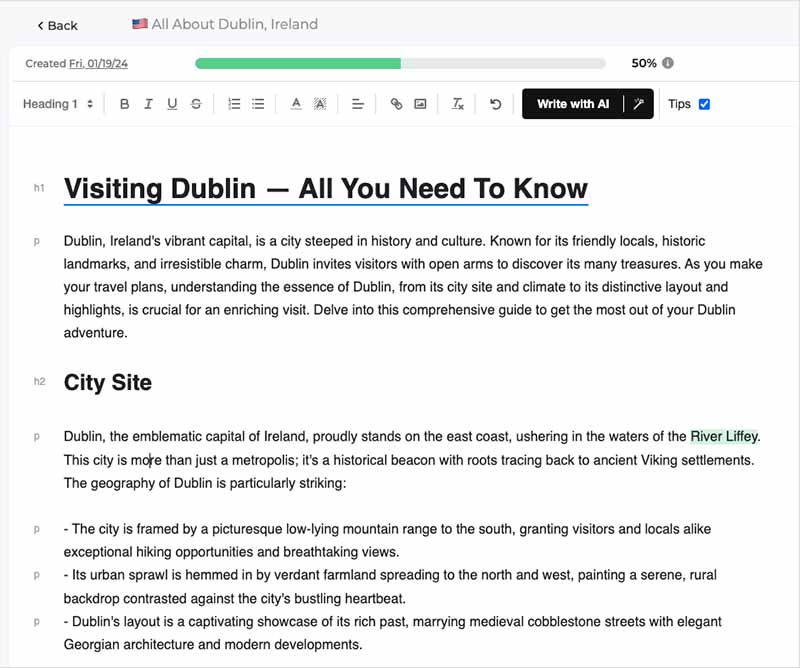
As is the case with all AI content generation tools, it’s important to read through the generated text to check for any inaccuracies.
I was reasonably happy with Growthbar’s first draft, both from a content and grammar point of view; but I did feel the need to edit it a bit — my draft contained too many bullet points for my liking as well as a few cringey headings (pictured below).

So a little bit of editing of titles and body text may be required, depending on the topic involved.
If you want to develop your first draft further, you can use GrowthBar’s other content generator tools to create more content.
These tools are divided into three sections: ‘Optimize,’ ‘Drag-and-Drop’ and ‘Chat’

In the ‘Optimize’ section, you’ll find three things:
- a keyword difficulty score — this tells you how hard it will be to rank highly for the topic you’re writing about
- some ‘optimal content’ targets for your post — the number of words it should contain, the URL you should use for it, how many headings it should have and so on
- keywords your posts should contain.
The screenshot below shows what was surfaced during my test of the tool for my ‘Dublin’ post.

Now, as you can see, this is all pretty useful stuff — but GrowthBar could be a bit clearer about whether the ‘difficulty’ score refers to the suggested post title or the phrase I used as the basis of my content generation.
What I did really like however was the ‘optimal content’ panel (pictured below).

This gives you really clear objectives to aim for when creating a new piece of content, including:
- word count
- URL structure
- headline count
- number of external links to include
- number of internal links to include
- image count.
According to GrowthBar, this is surfaced via a propriety ‘topic modelling’ technology that analyzes 100+ high-performing pages on your topic.
Once you’re happy with your overall draft, you can use GrowthBar’s additional content generation tools to complete it.
You’ll find most of these in the ‘Drag-and-Drop’ section on the right-hand side of the GrowthBar interface:
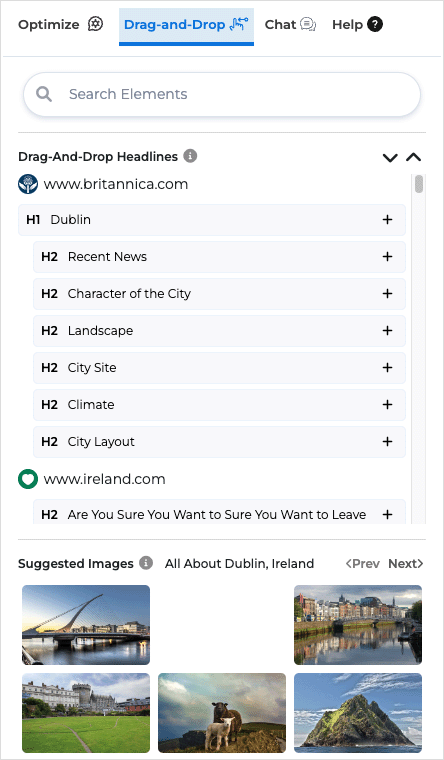
As you can see from the screengrab above, there are two sub-sections here: ‘Drag and Drop Headlines’ and ‘Suggested Images’.
The drag-and-drop headlines feature is really useful. This lets you see what headings your competitors are using in top-ranking articles about the same topic (along with the relevant level — H1, H2, H3 etc.), and helps you ensure that your post is covering the same ground.
The suggested images section surfaces images used in similar posts into yours (and gives you the URLs where they can be found).
This is a nice idea in theory, but doesn’t work so well in practice, because many of the images that are surfaced are not royalty free (so you could get charged a fee by their owners if you use them).
Ultimately the suggested images feature is great for getting an idea of the type of images used in high-ranking posts — but not for sourcing images. I’d prefer to see a direct integration with a royalty-free image site like Unsplash: this would give you images that you could actually use without problems in your posts.
The third content tool the development panel gives you access to is Growthbar’s ChatGPT-powered ‘Chat’ feature. You can use this to carry out additional research for your article by asking questions or requesting additional information that you want to add to your draft.

There’s one more aspect of the blogpost generator tool to consider, and a very important one: its ‘Write with AI‘ button.

Located at the top of the copywriting window, beside the general formatting options, when clicked this inserts copy that GrowthBar’s algorithm reckons is relevant to your topic into your post.
The best way to the Write with AI button it is to add a new heading (or highlight an existing one) and then click it.
Here’s what I got when I added a H2 of ‘3 Facts about Dublin’ to my test article:

So what to make of GrowthBar’s content generator tool? Well, overall, I liked it!
It gives you some really useful ‘target’ data — particularly around word counts, headings, URLs and image counts. And you’ll get good content ideas from it — the AI content generator and list of competitor headings will help ensure that you are covering any topic in depth.
As with AI-generated content in general though, the results here can be rather hit and miss. Some of the content generated by the AI content button was really helpful — but some of it was a bit repetitive or inaccurate.
The key takeaway here is that GrowthBar’s Content Generator is great for structuring articles and providing basic copy. It’s not yet at a stage however that you could publish the content provided without editing and crucially, factchecking.
The paragraph generator tool
In addition to its ‘blogpost generator’ tool, GrowthBar also gives you a ‘paragraph generator’ tool. This outputs an AI-generated paragraph based on a keyword you enter.

This is potentially a useful tool if you’re updating an existing post and need some additional copy.
As for the content this tool generates, it’s of a similar quality to the copy provided by GrowthBar’s main ‘blogpost generator’ tool. But as with the content generator, it can provide food for thought and some reasonably usable copy (caveats about editing and factchecking still apply though!).
The paragraph rewriter tool
The ‘paragraph ‘Rewriter’ tool is an interesting feature. As its name suggests, you enter a paragraph into it and it gives you an alternatively phrased version.
I tested this using a paragraph taken from a news article in The Guardian newspaper. Here’s what I put in…
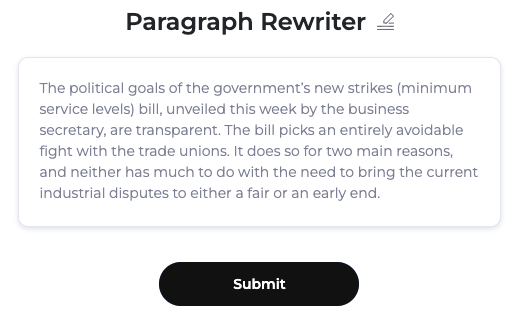
And here’s why I got out…

As you can see, the results were pretty good — the output content differs significantly from the input, and is well-written too.
It’s easy to see a potentially naughty application for this: plagiarising other texts. You could conceivably enter existing, high-ranking content into this and get ‘repurposed’ versions of it.
Somebody familiar with the original content could probably spot the copying of it, but it’s a next-level take on copy and paste that could fool a lot of humans and — although perhaps not for much longer — search engine algorithms.
The meta description generator
The meta description generator tool gives you meta descriptions, based on phrases you enter, that meet the character limits that are appropriate for search results.
I was pretty pleased with the results, although again accuracy errors were a bit of an issue from time to time — as you’ll see from the below example. When I asked GrowthBar to give me a meta description for this article title — ‘GrowthBar review,’ it gave me a description about an online course.

The blog ideas tool
The ‘blog ideas’ tool does what it says on the tin: gives you ideas for blog post titles, based on a phrase you enter.
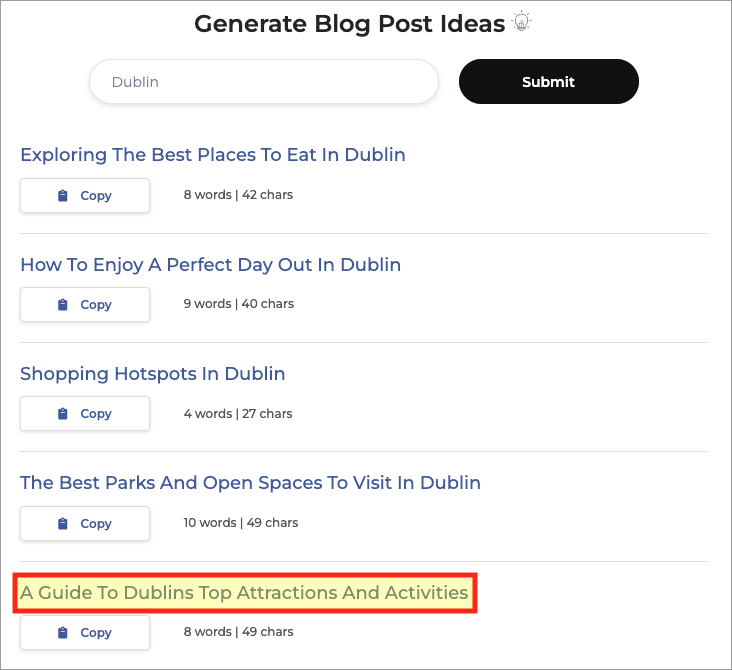
Some minor issues aside — see highlighted example above of a grammatical error — I was pretty pleased with the results from this tool.
One thing that’s missing here however is keyword difficulty scores — if you like the sound of a particular title, you’ll be in the dark regarding how easy or hard it will be to rank for it. It would be good if this additional context was provided by the tool.
GrowthBar’s SEO tools
So far, we’ve looked at GrowthBar’s content-generation tools. In addition to these, GrowthBar gives you access to 3 more ‘conventional’ SEO tools: a site inspector, a keyword research tool and a rank tracker.
Let’s take a look at these.
The ‘keyword research’ tool
As the name indicates, GrowthBar’s keywords research tool lets you get keyword data / suggestions based on a phrase you enter.

The keywords section (pictured above) shows you:
- the number of searches per month for a phrase entered
- how hard it will be (on a scale of 1 to 100) to rank for that phrase
- a list of keyword suggestions — ‘related queries’ based on the phrase.
All very useful stuff — but there is an important omission: the keyword suggestions are not accompanied by their keyword difficulty scores.
This means it’s hard to know which keyword opportunities suggested are actually worth pursuing. Granted, you could enter individual keywords back into GrowthBar to get this data — but that would be a rather time-consuming affair.
Trying GrowthBar out for free
Like many competing SEO tools, you can try GrowthBar out for free before committing to it. The company has made a 7-day free trial available, which you can access via this link.
The ‘keyword roadmap’ tool
Growthbar’s ‘keyword roadmap’ tool lets you work out which keywords in your competitive niche are the most valuable.
The keyword roadmap shows you:
- the Google rank of your website for a given keyword
- the Google rank of your competitor’s site for that keyword
- an opportunity score for each keyword
- monthly search volume for each keyword
- the cost per click for each keyword
- the financial value of ranking first for a keyword
- a difficulty rating for each keyword.
Of these metrics, the ‘Opportunity Score’ is the most important, because this is an aggregated score assigned to keywords by Growthbar based on all of the other variables listed above. According to the company, “high opportunity score keywords are ones that should yield the highest revenue with the least amount of effort”.

For me, the keyword roadmap tool has two key benefits.
First, you can audit your own website to see which high-opportunity keywords you currently rank well for, allowing you to work out what existing content its best to focus on optimizing further for even higher rankings.
And second, you can use it to identify keywords that your competitors rank for but you do not; and then develop brand new content around those keywords to up your competitive edge in your particular niche.
The main drawback of this feature when compared to similar tools available in platforms like Semrush and AhRefs is that you can only analyze your site against one competing domain at a time. By contrast, Semrush lets you compare your site against 5 competitors domains, and AhRefs lets you do so against 10.
Site inspector
The site inspector is a simple domain analysis tool. It lets you enter a domain and then shows you:
- its authority
- an estimate of the monthly traffic to it
- a ‘plus’ icon that lets you view key backlinks to the domain
- a Google icon that lets you view information about the Google ads that the owner of that domain is running, plus associated ‘cost-per-click’ data
- the keywords for which the site currently ranks highly.

Although the data provided is very simplistic by comparison to the sort of domain analysis you’d see in more expensive apps like Ahrefs or Semrush, it nonetheless provides a clear overview of the essential information you might want to find out about a domain.
One thing to be rather wary of however is the ‘organic traffic’ estimate; on some occasions (and based on having access to traffic data for quite a few sites) I found the GrowthBar estimates were way out.
To be fair to GrowthBar however, this is often the case with SEO tools — the traffic estimates you get from Ahrefs and Semrush can be inaccurate at times too. So, regardless of the SEO tool being used, it’s generally best to use traffic estimates as indicators of trends rather than absolute gospel.
But that said, the traffic estimates I got from GrowthBar bore so little resemblance to the site data I had access to that I’d probably be inclined to ignore them.
Overall, you’ll find that GrowthBar’s Site Inspector gives you the key information you’ll need to sense check a website’s SEO condition — either yours or a competitor’s — but I would like to see one metric added: a ‘total backlinks’ figure that lets you see exactly how many backlinks point to the website you enter.
Although you can access a list of key backlinks to a site via the GrowthBar site inspector, this is limited depending on the plan you’re on (more on this later).
And, unlike other SEO tools, GrowthBar doesn’t seem to give you a total figure of how many links point to a specific domain.
What about broken link building?
A link building tactic that you won’t really be able to engage in using GrowthBar is broken link building.
Broken link building involves identifying content in your niche that is no longer live, recreating a version of it and then approaching webmasters who had previously linked to that content (asking them to replace the broken link with a link to your new resource).
Unfortunately there isn’t really a way in GrowthBar to identify these broken links — so if this particular SEO tactic is important to you, you’ll need to look elsewhere (other SEO tools like Semrush and Ahrefs do have this as a core feature).
The rank tracker
GrowthBar’s rank tracker lets you enter a domain and a keyword and see:
- a monthly traffic estimate for that domain
- how high that domain ranks for the keyword you entered

You can use this section to keep tabs on how your ranking is progressing over time, thanks to a ‘best rank’ and ‘change’ column in the data table, and a graph on the right hand side of the screen.
This effectively gives you ‘sense-checking’ data rather than a detailed analysis of how your ranking for a particular keyword has progressed over time — it’s doesn’t yet compete with the more fully-featured rank tracking tools provided by competitors.
Additionally, unlike many competing SEO tools, GrowthBar’s rank tracker does not currently allow you to track rankings by region or locale.
The Chrome extension
As discussed above, GrowthBar comes in two flavors: the ‘standalone’ version, which I’ve just covered, and a Chrome extension.

The Chrome extension basically changes all your Google search results so that in addition to providing descriptions of and links to relevant web pages, they also display SEO metrics. This is an interesting idea, and the thing I like most about GrowthBar.
Once you’ve added the GrowthBar extension and entered a keyword into Google, the first thing you’ll see is a ‘keyword difficulty’ score for that phrase. This give you a sense of how hard it will be to rank highly in search results for it (the higher the value returned, the higher the difficulty).

You’ll also see a little strip (the ‘growth bar’ itself) underneath each search result.

This gives you the following data about each website in the results:
- its domain authority
- an estimate of organic traffic to it
- the top keywords that it ranks for
- the top backlinks pointing to it
- any paid keywords being used by that site
- any Facebook ads being run by it.
In some cases — for example, where domain authority and organic traffic stats are concerned — the data is immediately visible.
In others, you need to click on a plus symbol on the strip to see the data. Doing so brings up a box containing the relevant metrics.

You also see a little ‘Words’ link beside each search result; clicking on this shows you its word count.
This is useful data, as there is often a correlation between page length and performance in search results. Knowing how many words are in a top-ranking article can help you craft a piece of content that is of a similarly SEO-friendly length.

That said, I didn’t always find that the word count provided was particularly accurate (partly, I think, because the feature counts not just words in a blog post but those in the comments section too).
Ease-of-use
There’s no doubt about it: GrowthBar is very easy to use.
This is possibly because it’s considerably less feature-packed than most SEO tools — but it’s also down to the fact that a lot of thought has gone into prioritising key SEO features, ensuring that they work in a simple way, and presenting the data provided in an easy-to-understand format.
So long as you are familiar with the basic principles of SEO, the ‘standalone’ version of GrowthBar involves virtually no learning curve at all.
The Chrome extension version is also sublimely easy to work with — it’s simply a case of entering phrases into Google and having all the key metrics put right in front of you.
The bottom line is that it’s hard to imagine new users having too much difficulty learning how to use GrowthBar.
So long as you’ve got a basic understanding of key SEO principles, you’ll find GrowthBar very easy to get to grips with — and this is one of its key selling points.
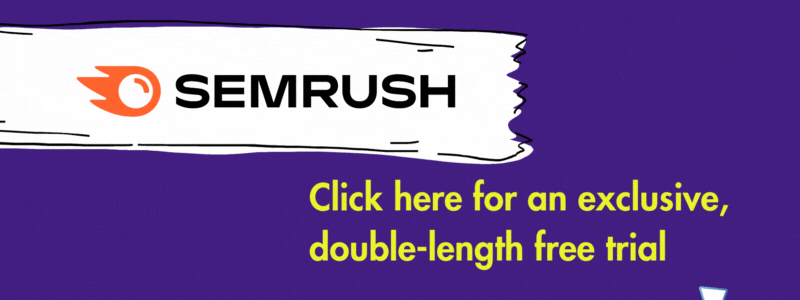
Pricing and value for money
The best thing about GrowthBar is the price of its entry-level plan, ‘Standard’ — this is available for just $29 per month if you pay upfront for a year, or $48 per month if you pay on a monthly basis.
This means that on this plan, you can get a lot of SEO data at a much lower price point than competing tools like Ahrefs or Semrush, which have monthly plans that start at $129 and $139.95 respectively.
It’s worth mentioning that all plans come with unlimited keyword research data — you can look up as many keywords every month as you like with GrowthBar, which is not the case with competing solutions.
Other limits do apply to the GrowthBar plans however, and they’re relatively tight on the ‘Standard’ plan. AI blog post generator articles are limited to 25 per month; rank tracking is limited to 25 phrases across 1 website; the keyword roadmap tool is limited to two uses per month; and you can only generate 500 AI paragraphs with it.
Additionally, the number of competitor keywords and backlinks is limited to 300 per query on the ‘Standard’ plan.
To increase these limits, you’ll need to upgrade to either a $99 per month ‘Pro’ or $199 per month ‘Agency’ plan. These increase your ranking tracking limits to 1,000 keywords across 3 sites, and 5,000 keywords across 25 sites respectively. They also facilitate more AI-created content outlines each month (100 and 300 respectively). You also get more uses of the keyword roadmap feature (2 and 25 respectively) and they are more generous when it comes to the numbers of competitor backlinks and keywords they output.
It is important to note that these monthly costs are based on paying upfront for a year — the ‘Pro’ and ‘Agency’ plans cost $99 and $199 per month if used on a rolling basis.
(Growthbar occasionally offers generous discounts on these prices. At time of writing — January 2025 — the company is offering up to 35% off the normal price point on its 3 pricing plans.)

For me, the best value plan is the ‘Standard’ one as it gives you the AI features — arguably the most useful thing about GrowthBar — plus some basic keyword research tools for a price that is genuinely competitive when compared to the likes of Semrush, Moz and Ahrefs.
Customer support
Although email support is provided by GrowthBar, it’s not immediately obvious where to find it — the email address is not displayed anywhere in the interface (and there aren’t any links to help resources or FAQs provided within the tool’s interface either).
The support address is listed on the home page of the GrowthBar website though — albeit in the footer!
You do get emailed a video walkthrough of the product when you subscribe to it however, which is helpful, along with contact details for the founders. So you will be able to get support — it would just be better if the process for accessing it was more obvious.
On the plus side, I can’t imagine too many people actually needing much support with this tool — it’s very easy to use.
GrowthBar review: summary
For me, the main thing that GrowthBar has going for is it AI features. For a relatively low price you can get your hands on some really good tools for creating blog posts (or sparking ideas for them). These tools have to be used with caution — not least because Google doesn’t approve of AI being used to create content — but if you’re smart about their application, and prepared to put in some editing and factchecking hours, the AI copywriting features of GrowthBar definitely have some serious uses.
As for the other SEO tools, they’re a bit underwhelming and don’t yet compete with those of more established SEO tools like Ahrefs, Moz or Semrush, but their inclusion on the reasonably priced ‘Standard’ plan is welcome and makes that plan in particular a good value proposition.
GrowthBar won’t be for absolutely everyone, but there’s lots to like about it, especially if you want to get into the whole world of AI copywriting. It’s well worth trying out, especially if you’re on a low budget — you can access a five day trial for free here.
I’ll leave you with a summary of the key pros and cons of GrowthBar.

Pros and cons of GrowthBar
Pros of using GrowthBar
- Its AI tools give you a fast way to create blog post outlines, spark ideas for content creation and even write copy.
It’s easy to use.
Its entry level plan is cheap.
It gives you the key data you need to execute a simple but effective SEO campaign.
The Chrome extension provides a unique, fast and really easy way to access SEO data ‘on the go.’
No limits apply to keyword research or domain queries.
It can be used for free for 7 days.
Cons of using GrowthBar
Its regular SEO features are pretty basic.
The keyword suggestion list doesn’t display keyword difficulty scores.
- The AI content generation tools are great for sparking ideas for blog posts — but using them effectively will involve a lot of fact-checking and editing.
- You can’t really do broken link building with GrowthBar.
- The keyword roadmap tool only lets you compare your site against one competitor at a time.
- It could be easier to access customer support details.
Our overall rating: 4 / 5
Alternatives to GrowthBar
There are lots of SEO tools on the market — the best known ones are probably Ahrefs, Semrush, SpyFu, Similarweb and Moz. You can check out our resources on these below:
The above tools differ from GrowthBar in that they don’t give you much in the way of AI content creation tools (Semrush and AHrefs give you some AI content creation tools if you make use of various add-ons).
The obvious alternative to GrowthBar for AI copy creation features is Open AI’s ChatGPT.
Want more SEO tips?
If you’re interested in finding out more about the whole topic of search engine optimization, and want to make really significant improvements to your site’s performance in Google, then do sign up to our mailing list below.
You’ll get all our latest free SEO resources in your inbox, along with other extremely useful tips for growing your online business.
Don’t miss out on our free SEO toolkit
For a limited time only we’re offering our readers some excellent free SEO tools and resources. Sign up now to immediately receive:
- our downloadable cheatsheet containing the 20 key steps to ranking highly in search results
- extended free trials and discounts for leading SEO tools
- our downloadable cheatsheet on how to grow organic traffic to a blog
- 2 in-depth guides to SEO
- ongoing free tips and advice on SEO and growing your business
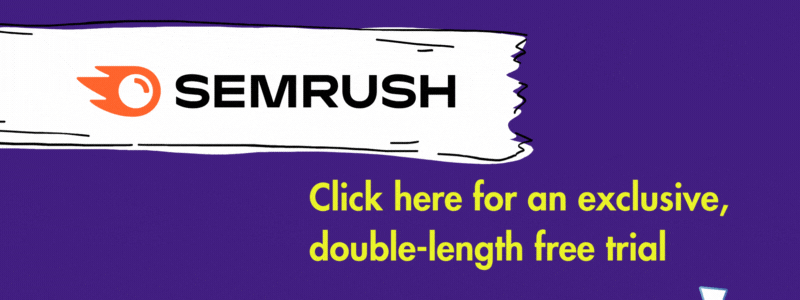
Comments (4)
Brilliant review, which also served as a kind-of demo – thanks for that!
You need to update your “Pricing and value for money” section, as GrowthBar have made some changes there…
Thanks — just to let you know that this section (and the review as a whole) has now been updated 🙂
Thank you so much for this article! I wasn’t sure about what SEO plugin to get for my blog because Ahrefs and Semrush were both really expensive. This helped a lot for my research.
Cheers Yuvika! I’m glad to hear that you found the review useful, and good luck with the continuing research.